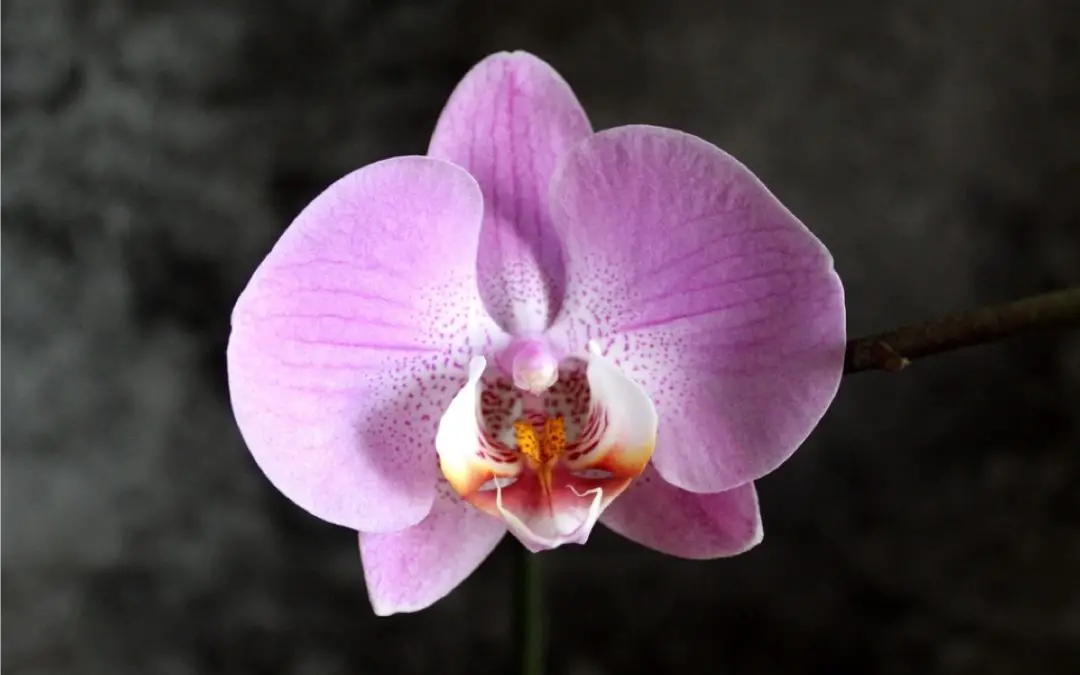Your motivation is probably to add some accent plants, to get a splash of color. Orchids are stunning and can definitely accomplish this. Here are some options:
Orchids are a stunning option for adding a pop of color to a living wall. Some of the best orchids for a living wall are: Oncidium (Dancing Lady), Dendrobium Berry Oda, Phalaenopsis (Moth orchids), Psychopsis (Butterfly orchid) and Cattleya orchids. Orchids require conditions that can be difficult to achieve in a living wall alongside varied tropical plants. Antheriums and Crotons are commonly used alternative accent plants. They are colorful and easy to grow.
Orchids are fairly different from most plants. They’re epiphytes and require quite a lot of ventilation around their roots. Not all situations are going to give orchids a good chance to succeed.
The first step is to ask yourself:
Is your wall right for orchids?
Orchids are beautiful. That much is certain. But, they’re no walk in the park.
They’re an interesting addition to any living plant wall, but they’re particularly suited to smaller walls. A smaller wall allows you to get closer the orchids and really appreciate them. You can imagine a large atrium or lobby, orchids might not be noticed enough to justify the challenge of growing and integrating them into the wall.
The first step to figure out your temperatures, moisture, humidity, and light conditions. Do you have the right conditions to provide your orchids the conditions they need?
A quick note:
Humidity refers to the water in the air.
Watering refers to the water that’s added to the growing medium.
Some plants are more tolerance of higher humidity, and less watering, and vice versa.
Many Orchids are epiphytes, growing up in the canopy. Growing on the bark trees and vine, they prefer less nutrients, more humidity, more air flow, and better drainage than a lot of plants. Including a lot of tropical plants.
So, this means your wall might require separate irrigation zones and other complications. It can be done, and there are some beautiful examples out there. The important thing is to understand the potential implications on cost.
Another key principle with orchids is: no wet feet. Orchids have evolved to absorb water into their root sheaths (velamen). This means they’re generally adapted to short bursts of water, and then draining.
Without drainage, the roots suffocate and rot, which can spread to healthy roots.
A common misconception is that orchids can be watered with ice cubes. They’ve evolved in warm climates, why would they like ice? Use room temperature water. Misting of the leaves and roots (but not the flowers) can be okay, but only if there’s good ventilation (or dry air, like in many non-coastal cities), or a balanced ecosystem (like a bio-active setup with whitetails) so mold doesn’t take-over.
Orchids are unruly
But with every rule there are exceptions! Some orchids can survive long torrential rainfalls where their roots are completely underwater for extended periods! Phragmipediums are terrestrial or lithophytic, many of these orchids prefer wet feet. Just remember, orchids are very diverse, so there are no (or very few) rules that will apply to all orchids.
Top 5 Orchids for living walls
5. Cattleya Orchids
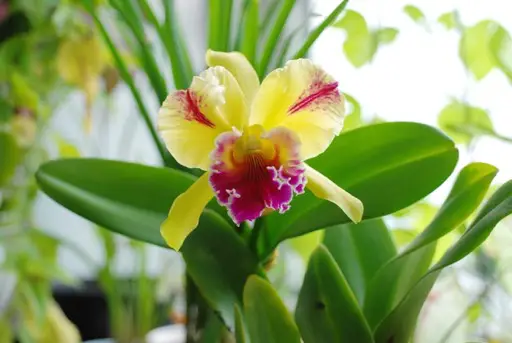 Blooms
Blooms
The blooms are typically shorter, around 3-4 weeks. If they won’t bloom it’s likely because they’re not getting enough light. Can bloom multiple times per year. Bloom colors: White, pink, purple, orange, yellow.
Growing Conditions
Cattleyas prefer moderate temperatures (except the Amazonian species, which prefer warmer). They prefer brighter light, even direct sunlight. So plant them nearest to the highest light intensity, near windows, skylights, or artificial lights.
It’s better to err on the side of watering less than more, let the soil dry out completely before watering. They’re not particularly worried about humidity, something in the typical indoor range of 35% to 50% is fine. Be careful when watering that water doesn’t become trapped in new growth. This can cause the new growth to rot.
Prefers very well-draining soil. Bark chips are a safe option for growing medium. They’re very resilient, and come back from fairly severe damage if given a good chance.
Availability
Cattleyas are popular orchids, so they shouldn’t be hard to track down. As with any specific plants, reach out to your nursery sooner rather than later, and you might have better luck.
More info from the American Orchid Society.
4. Psychopsis (Butterfly Orchid)
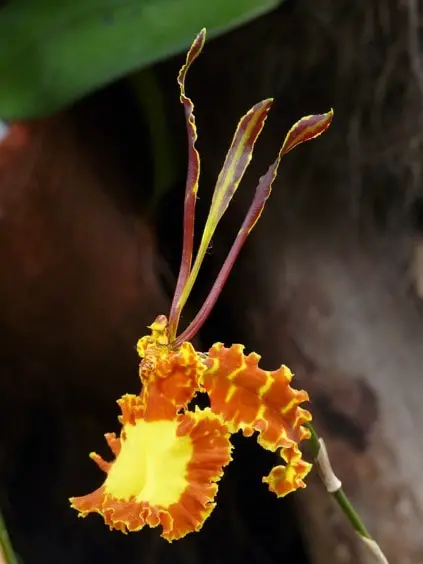 Blooms
Blooms
The Psychopsis can be called a sequential bloomer because it blooms within 3-4 weeks of dropping flowers. It works out to blooming around half the year. The inflorescence (flower stalk) can grow particularly long and break, support could be necessary. Bloom colors: white, yellow and orange.
Growing Conditions
They like lighting similar to Oncidium, but slightly less intensity.
They prefer moister soil but with good ventilation. Sphagnum-moss is not a well-draining enough growing medium. Well draining soil is good. Don’t use sphagnum moss as a growing medium, it will suffocate the roots.
Before watering, let the soil mostly dry out. The soil doesn’t have to be fully dry like a Cattleya. They’re not fussy about humidity, 35-40% okay. These are resilient orchids, and can handle repotting well.
Availability
These are more of a specialty orchid, so they’re tougher to source. Look to local Orchid groups online, or get in touch with your local Orchid society/association.
More info from the American Orchid Society.
3. Phalaenopsis (Moth Orchid)
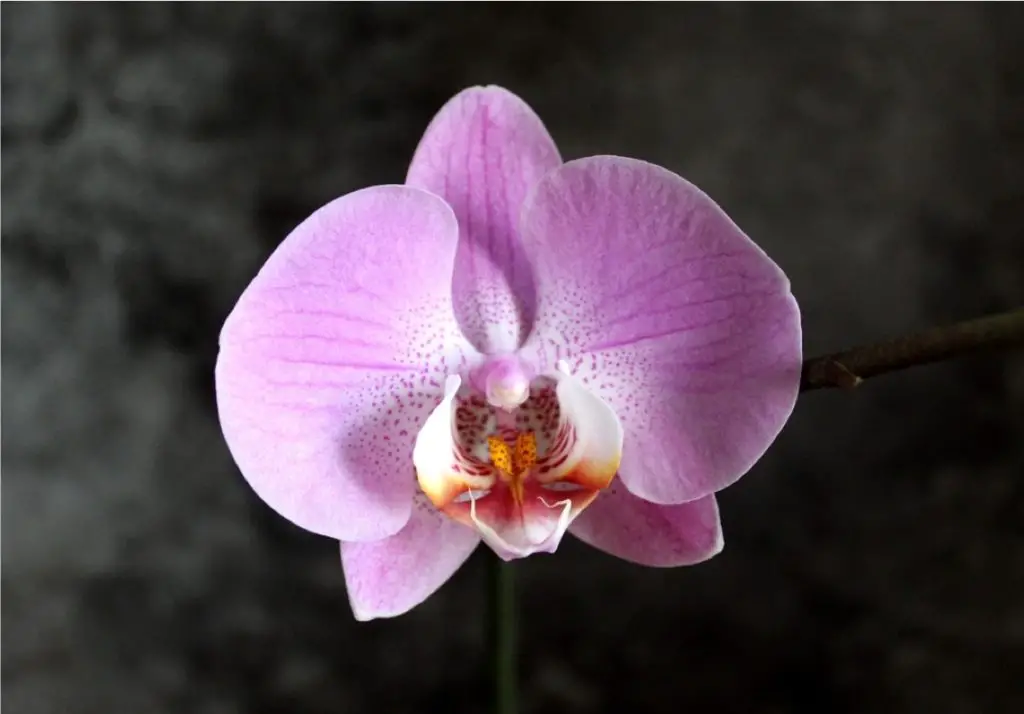 Blooms
Blooms
The blooms last for an extended period. These orchids can bud blast if temperatures are too low or lighting is too low.
Bud blasting means the orchid is reacting to something wrong or different in its environment. They drop their buds or blooms to conserve energy.
Phalaenopsis blooms usually have no fragrance. Bloom colors: Many colors and sizes of flowers available!
Growing Conditions
They’re not particularly picky about light. They’re tolerant of a fairly wide range of light conditions.
The Phalaenopsis orchid prefers infrequent watering. Water when the roots turn silvery, if they’re green it means the velamen is full of water and they don’t need more. They like a lot of ventilation around root area, a loose bark is a great growing medium. This orchid can lose almost all its roots and still come back. It’s very resilient.
Availability
These are very easily available, your local supermarket might even have them!
More info from the American Orchid Society.
2. Dendrobium Berry Oda Orchid
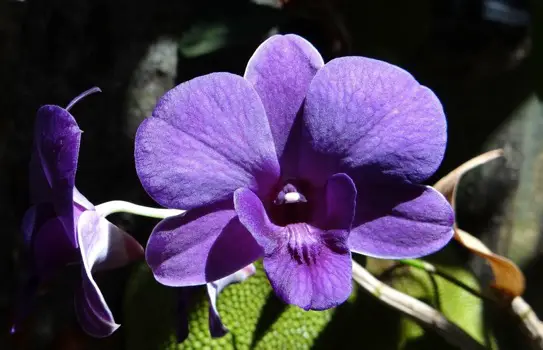 Blooms
Blooms
Blooms can last up to 3 months. They can smell really great. It’s a sweet smell. Produces smaller canes (flower stems) when lighting is lower. Bloom colors: Purple, pink and white common.
Growing Conditions
Dendrobiums like bright light.
Water when media is dry. The canes (flower stems) will shrivel when it needs water. Allowing the canes to shrivel slightly before watering can be a good indicator.
It’s a very resilient orchid, even if it has no roots there’s a good chance it will come back. It regenerates roots very easily.
Not prone to root or crown rot because the foliage is very separated from the stem. Root and crown rot occurs because of trapped water. It is particularly prone to attracting spider mites.
Availability
This orchid is popular, but you might not find it at a supermarket. A larger nursery or local orchid groups might be good places to look first.
More info from the American Orchid Society.
1. Oncidium (Dancing Lady Orchid)
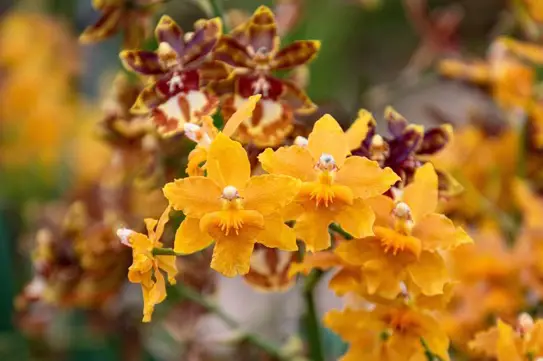 Blooms
Blooms
Oncidiums often bloom in winter. They have a massive inflorescence (flower stalk) that can get really top heavy, huge flowers. Oncidums flowers easily and prolifically. Not prone to bud blast. They like strong light. They like between 40-80% sun exposure, which is very high! (But not as high as Cattleya).An bloom multiple times per year. Some are very fragrant.
Growing Conditions
Like bright lights, don’t need sunlight, but as bright as you can.
Almost identical in care to a Phalaenopsis.
Watering: let medium begin to dry (not bone dry, but don’t keep it wet), and keep ventilation high, including using well draining soil. Not picky with humidity. Likes slightly moist soil. More tolerant of frequent watering. Produces roots easily. Can withstand low and high temperatures better than phalaenopsis. You shouldn’t need to worry about humidity, oncidium thrive between 30-60%.
They’re a huge group of orchids, so many are available. Ideally they prefer a temperature difference between day and night. But that’s in a perfect world.
Availability
These are easily available because they’re one of the easiest types of orchids to grow. They’re practically indestructible (for an Orchid).
More info from the American Orchid Society.
Alternative Accent plants
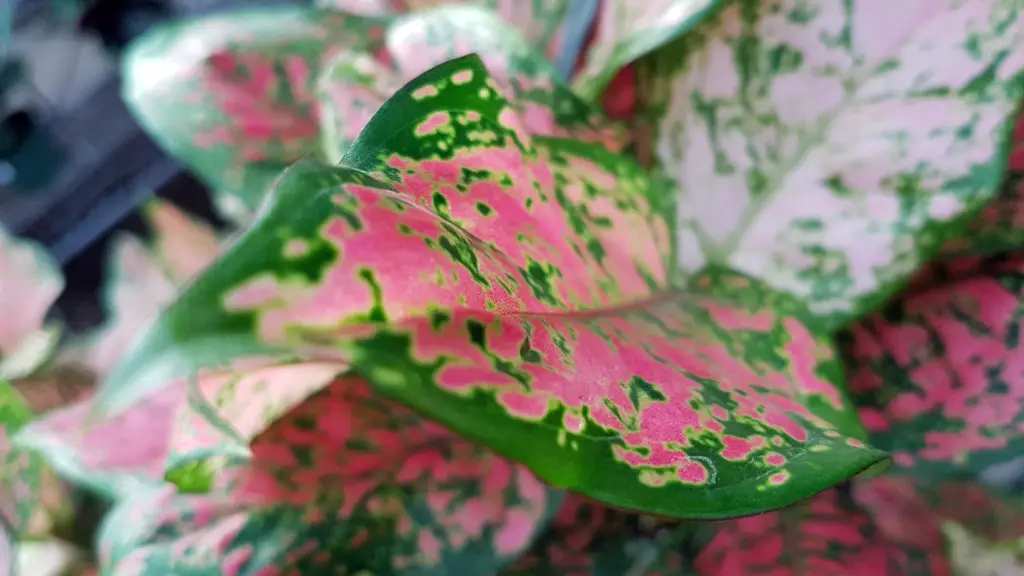 If you’re not up for the challenge of orchids (which is very reasonable), consider another accent plant! Antheriums and Crotons are commonly used to provide a splash of color, without the intricacies of culturing orchids.
If you’re not up for the challenge of orchids (which is very reasonable), consider another accent plant! Antheriums and Crotons are commonly used to provide a splash of color, without the intricacies of culturing orchids.
Accent plants can add color through their flowers, but also through their leaves. Certain plants have leaves that can turn incredible colors under the right conditions.
They’re more commonly available than you might guess.
Anthurium Andraeanum (Lace Leaf)
 Easy to grow and easy to find. There are a lot of different varieties. Anthuriums are a genus of around 1000 flowering plants!
Easy to grow and easy to find. There are a lot of different varieties. Anthuriums are a genus of around 1000 flowering plants!
Blooms
Red and pink are common, white is possible. Cut blooms that are declining, crispy, and discolored. They can flower all year under the right conditions.
Growing Conditions
Anthuriums are Epiphytic (take in a lot of nutrients from the air). They like a loose draining mix. They don’t like salt buildups, so it can be good to repot occasionally, and water with a lower salt/mineral water like distilled, reverse osmosis, or rainwater.
Airflow is important, as an epiphyte good ventilation is required. Partial drying out is okay but not too much. Coarse, quick draining soil is recommended.Anthuriums are more tolerant of underwatering than overwatering. Don’t overwater.
They like shade in a forest, which is a brighter but indirect sunlight location in a house. If leaves get too much sun the green will be duller. The plant will compensate by lowering chlorophyll levels. You want nice dark green leaves with a slight gloss.
They’re tropical, and they like humidity, so they’re good for a bathrooms and the regular humidity from showers.
Availability
Anthuriums are a popular plant because they’re easy to grow and have great color contrast. You shouldn’t have trouble tracking these down at any well stocked nursery.
Codiaeum Variegatum (Crotons)
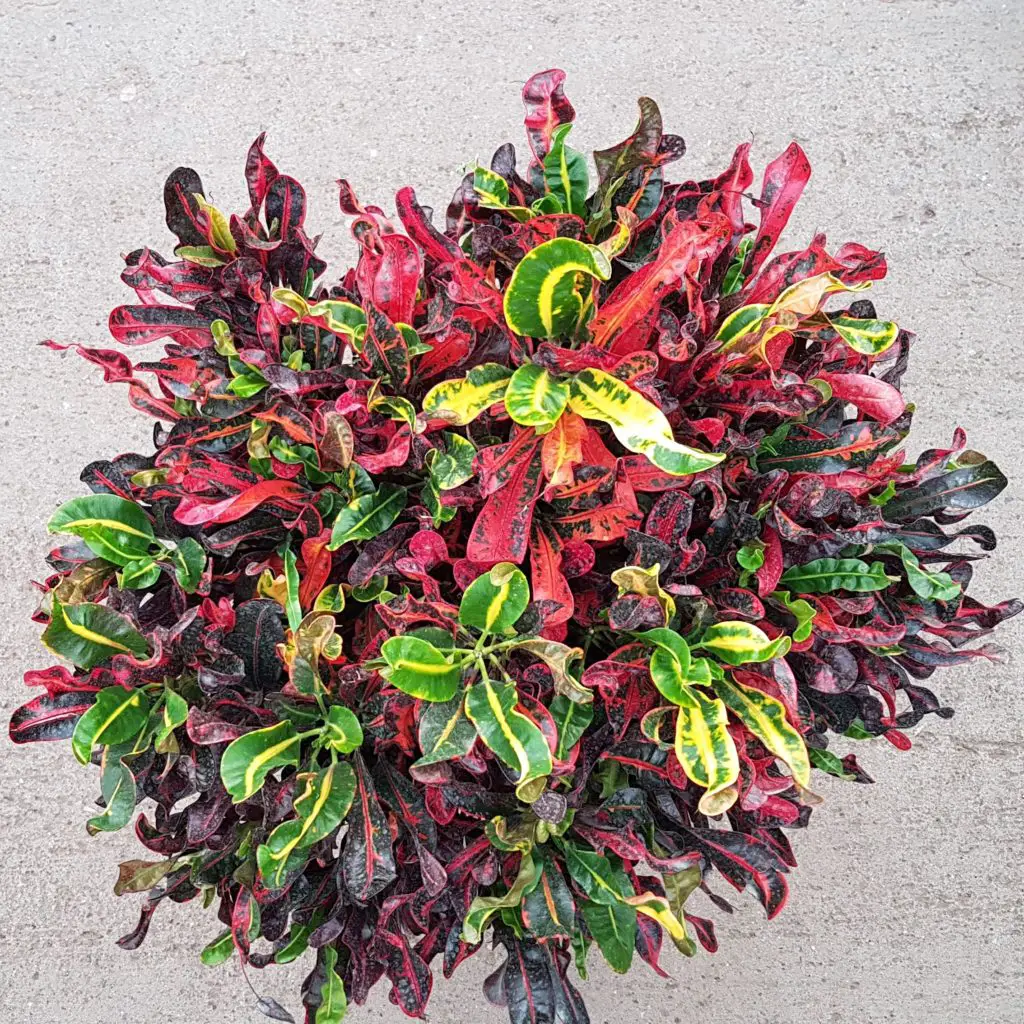 Crotons are everywhere, and they’re a lot more forgiving than orchids.
Crotons are everywhere, and they’re a lot more forgiving than orchids.
Blooms
For Crotons, the color doesn’t come from the flowers, but from the leaves. New growth is green. If the leaves are receiving enough light, they’ll slowly change color to bright yellows, reds and oranges. Bright light is recommended, but not direct sunlight or leaves will look dull and less saturated with color.
Growing Conditions
These plants can thrive once they’re established, but they don’t like to be moved. They can drop leaves when conditions change, but they’ll bounce back if the environment is still suitable.
They like warm, humid, bright environments as they’re native to South East Asia.
They prefer consistent conditions so they make a great indoor plant. They like humidity, misting with distilled, reverse osmosis or rain water will help Crotons thrive.
They like a well draining rich soil. Peat moss, compost, and perlite make a good mix for crotons. Leaves may droop when they need water, which can be a good indicator.
Availability
Crotons are a very popular plant. Supermarkets, big box stores, and nurseries are likely sources. You might have your choice of multiple varieties.
Warning
These plants are particularly toxic if ingested. Keep it out of reach of animals or children that you know have a taste for houseplants. Sap is a skin irritant, which might cause a little rash.
Conclusion
Orchids can make a great accent plant to add color to a living wall. Five good orchid-beginner-friendly options are: Oncidium (Dancing Lady), Dendrobium Berry Oda, Phalaenopsis (Moth orchids), Psychopsis (Butterfly orchid) and Cattleya Orchids. However, even an “easy” orchid is still an orchid.
Alternatives accent plants for giving a splash of color to a living wall are available. Antheriums and Crotons are popular.

I’m Alex Lafreniere. I learned a lot about plants when I built and operated a landscaping company. But, there’s always more to learn. Ever since travelling across the world, I’ve wanted to find ways to bring more tropical and exotic plants into my life. This is the site where I share everything I’ve learned with you.
This site is owned and operated by Plant Hardware, a sole proprietor headquartered in Calgary, Canada. Plant Hardware is a participant in the Amazon Services LLC Associates Program, an affiliate advertising program designed to provide a means for sites to earn advertising fees by advertising and linking to Amazon.com.Plant Hardware may also participate in affiliate programs with Bluehost, Clickbank, CJ, ShareASale, and other sites. Plant Hardware is compensated for referring traffic and business to these companies.

